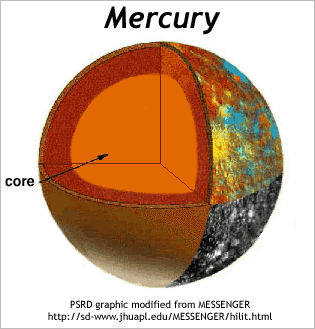
In many ways, Mercury has more in common with the lifeless moon of our own planet than with the other terrestrial planets. Its face is scarred with ancient craters, the result of massive bombardment that occurred early in the solar system’s history. These craters remain untouched because Mercury has no water, erosion, or atmosphere to erase them. The closest planet to the sun—with an average distance of 960,000 miles (1,546,000 km)—
Mercury is difficult to observe from the earth, and can only be viewed near sunrise or sunset.
Its surface, revealed in detail for the first time in images transmitted by such unmanned probes as Mariner 10 (in the 1970s), is pocked with moonlike craters.
Mariner 10 also discovered a weak but detectable magnetic field around Mercury. As a result, astronomers concluded that the planet must have a core rich in molten iron. This contention is consistent with the planet’s position closest to the center of the solar system, where most of the preplanetary matter—the seeds that formed the planets—would have been metallic in composition

No comments:
Post a Comment